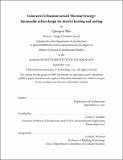Generative Urbanism toward Thermal Synergy: Sustainable urban design for district heating and cooling
Author(s)
Wan, Qianqian
DownloadThesis PDF (26.37Mb)
Advisor
Mueller, Caitlin T.
Terms of use
Metadata
Show full item recordAbstract
Thermal performance has a long legacy in urban morphology, where the climate is interpreted explicitly in the forms of settlements. Mediating the temperature has taken a large portion in the energy sector since modern times. Besides the passive techniques, a closer observation of the space conditioning mechanism and the nature of thermal energy may produce systematic improvement in energy efficiency while maintaining the comfort level. Specifically, the synergy between heating and cooling needs in the urban environment provides the chance to circulate heat with low primary energy consumption.
This thesis suggests heat recovery as a driving force in generative urban design, based on the echo between the mixed-use development ideology in the design world and the clustering of diverse user profiles suggested by thermal engineers. Contrary to the interdisciplinary collaboration convention, where urban design schemes are largely settled prior to the evaluation of infrastructural performance, this research explores the possibility to integrate engineering considerations into early phase design evolution and the impact of spatial features on energy performance.
The thesis proposes the synergy score metric as a preliminary evaluation method to evaluate urban contexts and design schemes from a scope of thermal overlap between heating and cooling loads. Being naturally compatible with computational design optimization workflow, the metric bridges the iterations of design generation, performance assessment and multi-objective optimization, and navigates the design variants to approach greater heat sharing potential in the land use allocation scenario. The thesis then investigates the district heating and cooling network as the infrastructural system that embeds the synergy idea in essence. It examines the energy flow in a heat sharing network through simulation and analyzes the relationship between spatial sensitive features and energy performance metrics.
The research explores the state-of-art performance-driven design optimization techniques and suggests a reproducible framework that couples design and engineering visions for integrated spatial and energy planning. Communicating at a methodology level in the design-engineering collaboration is the crux of contemporary smart planning toward a sustainable urban metabolism.
Date issued
2021-09Department
Massachusetts Institute of Technology. Department of ArchitecturePublisher
Massachusetts Institute of Technology